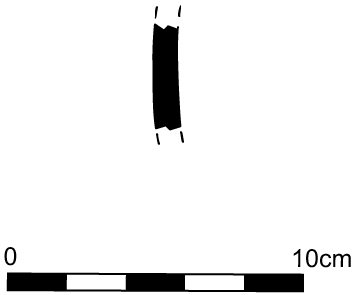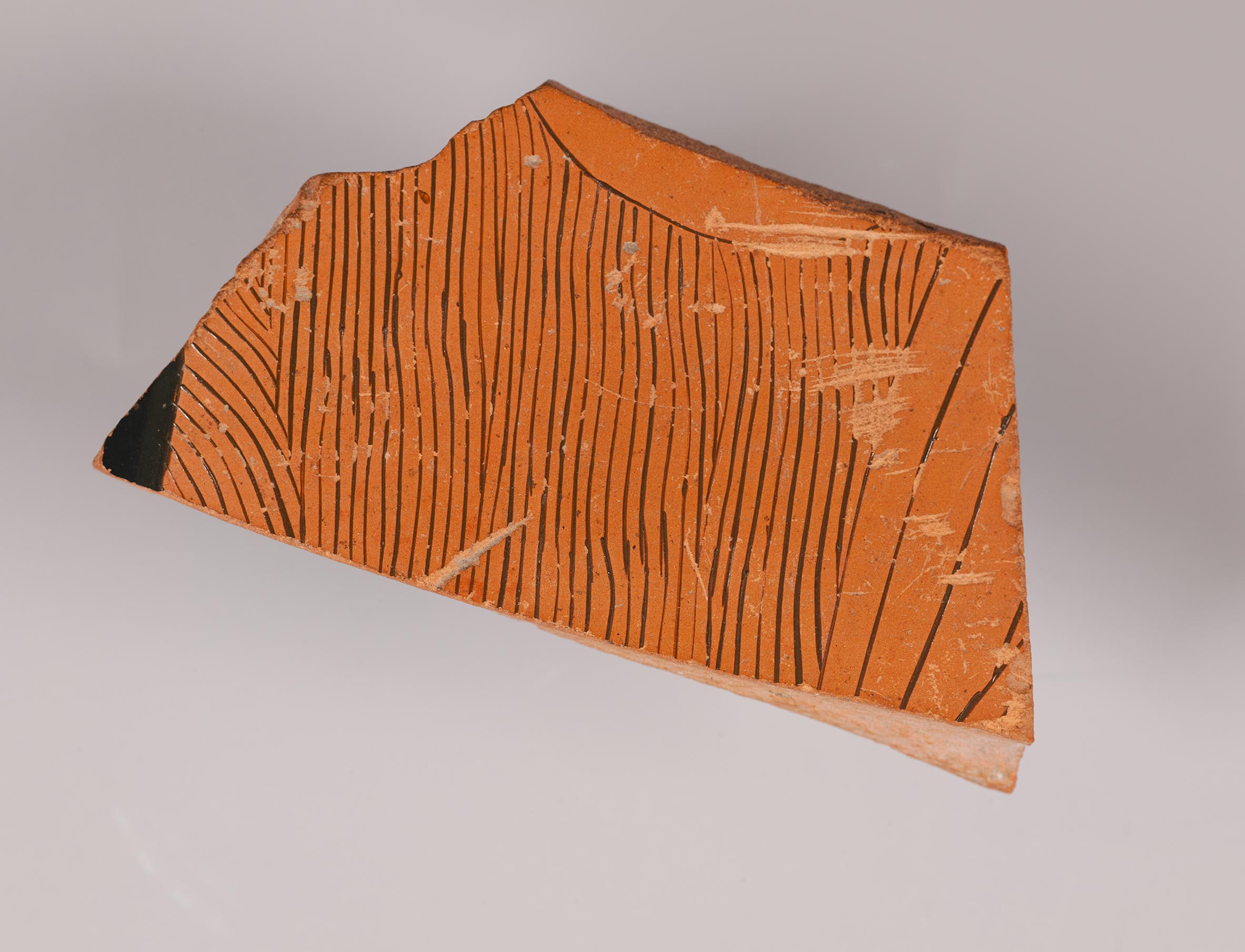Provenance
1985, gift, Mr. and Mrs. Peter Sharrer (Hillsdale, NJ) to Princeton University.
Shape and Ornament
Single fragment from the body. Interior black. No ornament preserved.

Subject
Woman. The fragment preserves the upper, frontal torso of a figure wearing a chiton and a himation, the latter draped over her left shoulder.
Attribution and Date
Possibly by the Villa Giulia Painter [J. R. Guy]. Circa 460 BCE.
Dimensions and Condition
6.1 × 3.5 cm; thickness 0.9 cm. Broken on all sides. Slight surface damage due to scraping, with parallel scratches extending from the neck of the figure to the himation.
Technical Features
Relief contour. All the drapery lines are drawn with closely spaced relief lines.
Bibliography
Unpublished.
Comparanda
The thickness and curvature of the fragment indicates that it comes from the wall of a calyx-krater. In a note in the fragment’s object folder at the Princeton University Art Museum, Guy suggested that the artist was possibly the Villa Giulia Painter, for whom see Abbreviation: ARV2J. D. Beazley. Attic Red-Figure Vase-Painters. 2nd ed. Oxford, 1963 618–28, 1662; Abbreviation: ParalipomenaJ. D. Beazley. Paralipomena: Additions to Attic Black-Figure Vase-Painters and to Attic Red-Figure Vase-Painters. Oxford, 1971 398–99, 514; Abbreviation: BAdd2Carpenter, T. H., ed. 1989. Beazley Addenda: Additional References to ABV, ARV2, and Paralipomena. 2nd ed. Oxford: Published for the British Academy by Oxford University Press. 270; J. D. Beazley, “The Master of the Villa Giulia Calyx-Krater,” Abbreviation: RMMitteilungen des Deutschen Archäologischen Instituts, Römische Abteilung 27 (1912): 286–97. The Villa Giulia Painter decorated a substantial number of large pots, including many kraters. Although little of the figural drawing is preserved on Princeton’s fragment, Guy’s suggestion was presumably based on the use of closely spaced relief lines for the upper chiton, which the Villa Giulia Painter employed on numerous occasions, favoring them instead of dilute gloss: cf. Reggio 4070 (Abbreviation: ARV2J. D. Beazley. Attic Red-Figure Vase-Painters. 2nd ed. Oxford, 1963 619.14 bis; Abbreviation: BAPDBeazley Archive Pottery Database. http://www.beazley.ox.ac.uk 207164); Detroit 63.12 (Abbreviation: ARV2J. D. Beazley. Attic Red-Figure Vase-Painters. 2nd ed. Oxford, 1963 621.42 Abbreviation: BAPDBeazley Archive Pottery Database. http://www.beazley.ox.ac.uk 207196); Cambridge GR.12.1917 (Abbreviation: ARV2J. D. Beazley. Attic Red-Figure Vase-Painters. 2nd ed. Oxford, 1963 623.66, 1662; Abbreviation: BAPDBeazley Archive Pottery Database. http://www.beazley.ox.ac.uk 207220). Note in particular, the slanted lines on the arms of the woman in Reggio, and the deep plunge of the neckline on one of the maenads in Detroit, both of which are paralleled on Princeton’s fragment. Although there is no indication of breasts, the figure is more likely than not a woman; cf. the name-vase of the Villa Giulia Painter, where there is scant or no indication of breasts beneath the women’s chitons: Villa Giulia 909 (Abbreviation: ARV2J. D. Beazley. Attic Red-Figure Vase-Painters. 2nd ed. Oxford, 1963 618.1, 1662; Abbreviation: BAPDBeazley Archive Pottery Database. http://www.beazley.ox.ac.uk 207149). Another candidate could be Apollo, whom the Villa Giulia Painter represented over a dozen times, though not always in both chiton and himation.

